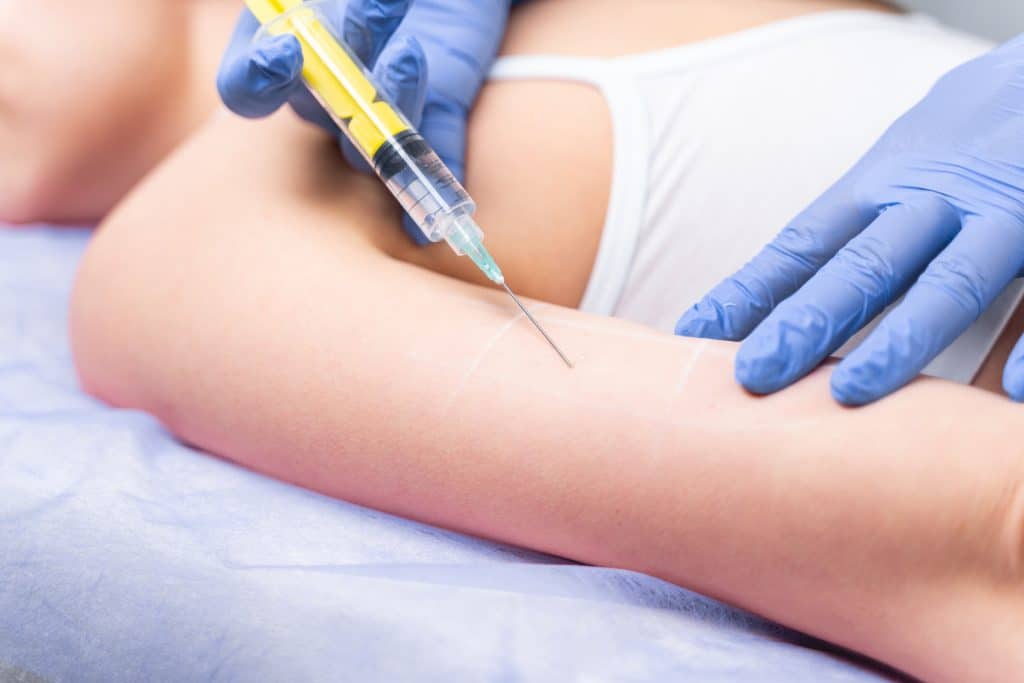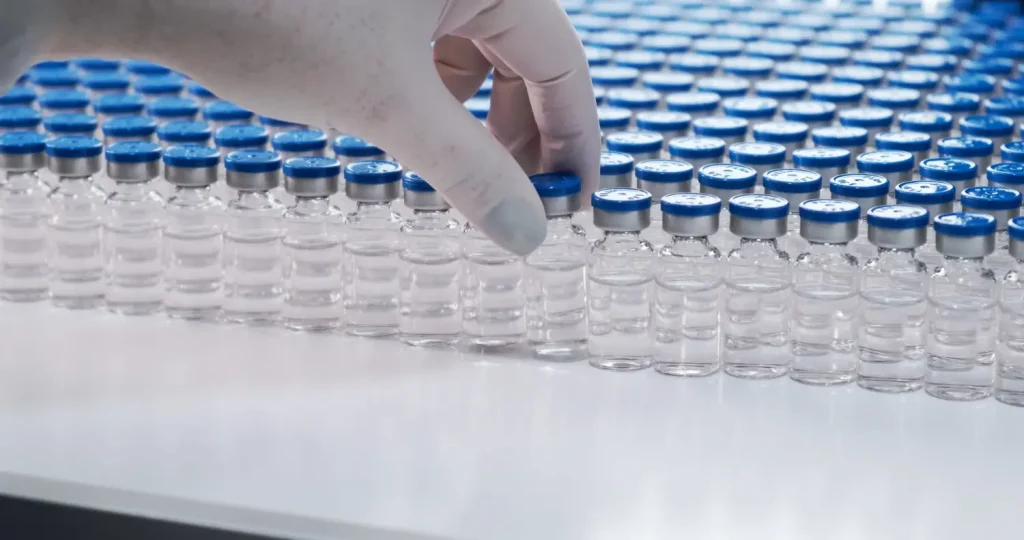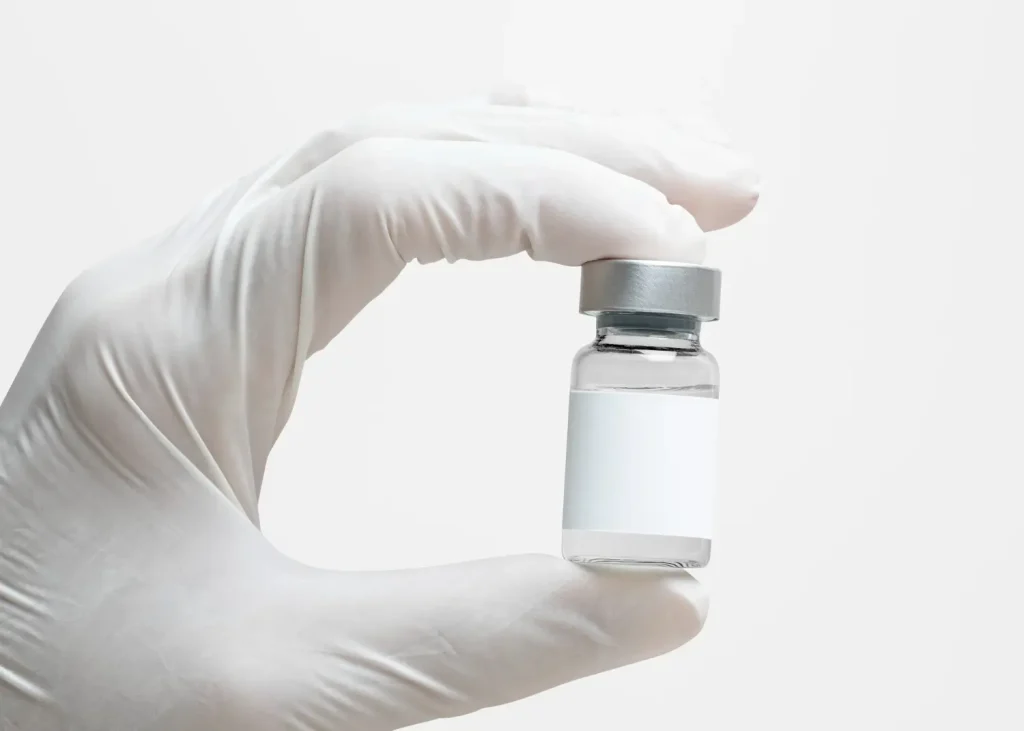Excessive sweating, or hyperhidrosis, challenges many people daily. It’s a condition that not only affects physical well-being but also impacts emotional health and social interactions significantly.
Research shows injectable treatments like Xeomin offer an 80 to 90 percent effectiveness in managing this distressing issue—providing hope and relief for those affected.
With years of experience in dermatology, I’ve seen firsthand the transformative power of Xeomin treatment in patients struggling with hyperhidrosis. My background has allowed me to understand the science behind why it works so well and how it can make a difference in someone’s life.
Keep reading to discover more about this effective solution.
Key Takeaways
- Xeomin is a safe and FDA – approved treatment that blocks nerve signals to sweat glands, reducing excessive sweating in areas like underarms.
- People who get Xeomin injections for hyperhidrosis see less sweat and feel more comfortable, which boosts their confidence and improves their daily life.
- Side effects from Xeomin are usually mild, including pain or swelling at the injection site, but it’s important to talk with a healthcare provider about managing these.
Understanding Hyperhidrosis

Hyperhidrosis is a medical condition marked by excessive sweating, not linked to heat, exercise, or stress. People with this condition may find their daily lives heavily impacted as normal activities become challenging due to the constant sweat.
Dermatologists and hyperhidrosis specialists have several ways to manage this issue, including antiperspirants specifically designed for severe cases, medications that reduce sweat production, iontophoresis – a technique using electrical currents to temporarily stop sweat glands – and nerve-blocking medications.
The prevalence of hyperhidrosis is notable, affecting millions worldwide. It can manifest in two types: primary focal hyperhidrosis where excessive sweating is localized in areas such as palms, feet, underarms, and face without an underlying medical cause; and secondary generalized hyperhidrosis which is the result of another medical condition or side effect of medication.
Common triggers include certain foods and drinks, nicotine, caffeine, and emotional stress. For those battling this condition seeking relief from its symptoms—treatments like Xeomin offer a ray of hope by providing an FDA-approved solution targeting excessive sweating at its source.
Let’s explore how Xeomin stands as an effective treatment option for managing hyperhidrosis.
Definition and impact on daily life
Hyperhidrosis is defined as uncontrollable excessive sweating that occurs regardless of heat, exercise, or stress. This condition disrupts daily activities, causing emotional and social distress for those affected.
Sufferers may find simple tasks challenging, from holding a pen to driving, due to the relentless sweat.
Excessive sweating can severely impact an individual’s quality of life, making even routine tasks difficult.
Despite being a medical condition, many overlook hyperhidrosis’s profound effects on a person’s well-being. Clothing choices become limited; social interactions are fraught with anxiety about visible sweat marks.
The psychological burden often leads to decreased self-esteem and confidence—highlighting the critical need for effective treatments like Xeomin in providing relief and restoring normalcy to patients’ lives.
Types of hyperhidrosis
Understanding the impact of hyperhidrosis on daily life sets the stage for exploring its types. Knowledge of these variations is crucial for providing targeted care.
- Primary focal hyperhidrosis affects specific body parts and usually doesn’t have an underlying cause. It most often targets palms, soles, underarms, and sometimes the face. This type tends to run in families, suggesting a genetic component. From my experience treating patients, those with primary focal hyperhidrosis often notice sweating that’s disproportionate to their activities or the temperature.
- Secondary generalized hyperhidrosis is broader and results from medical conditions or medications. Unlike its primary counterpart, it can start in adulthood and encompasses the entire body. Conditions like diabetes, thyroid problems, or infections often trigger this type. Patients describe a sudden onset of symptoms that disrupt their daily routine significantly.
- Idiopathic hyperhidrosis (IH) serves as another category recognized for its chronic nature without a clear cause. Individuals with IH experience excessive sweat production that can be both emotionally and physically challenging.
Each type of hyperhidrosis requires a nuanced approach to treatment. For instance, while xeomin botulinum toxin proves effective for primary focal cases by temporarily blocking sweat gland stimulation, secondary generalized hyperhidrosis might first necessitate addressing the underlying health issue. Consultation with a healthcare provider helps determine the most suitable path forward. In discussing options with patients considering xeomin treatment areas include underarms or palms where excessive sweating occurs most frequently—this dialogue ensures they have realistic expectations about xeomin how long to work and potential outcomes.
Introducing Xeomin as a Treatment Option

What is Xeomin treatment? Xeomin as a treatment option presents a noteworthy advancement in managing hyperhidrosis and excessive sweating. This prescription medication, distinct for its muscle relaxant properties, is engineered to temporarily enhance the appearance of moderate to severe frown lines but has found significant efficacy in addressing excessive sweating issues.
Unlike other botulinum toxin type A injectables, Xeomin stands out due to its lack of unnecessary proteins around the active molecule, potentially reducing antibody formation against it.
This property might make Xeomin an attractive choice for long-term management of hyperhidrosis.
Given clinical approval for various therapeutic uses, including muscle spasm reduction and improvement in certain eye movement disorders, Xeomin’s role in managing hyperhyprosis emerges from its ability to inhibit acetylcholine release—effectively stopping the nerve signals that trigger sweat production.
As medical professionals explore how often you can get Xeomin injections and delve into understanding what not to do after Xeomin treatment alongside post-care practices, they unlock new pathways toward enhancing patient quality of life who suffer from this condition.
Transitioning into discussing the mechanism of action offers deeper insights into how this innovative treatment reshapes approaches to hyperhidrosis management.
Overview of Xeomin
Xeomin is an FDA-approved treatment used to manage severe underarm sweating, known as hyperhidrosis. It stands out for being easy to inject and having a safe therapeutic profile. This medication works by blocking the nerve signals that cause the body to sweat excessively.
Both Xeomin and Botox fall into the category of botulinum toxin type A injectables, which are effective in treating hyperhidrosis. Xeomin’s ability to inhibit nerve communication helps prevent sweat gland stimulation in targeted areas, offering a potential solution for those struggling with excessive sweating.
Comparison with other botulinum toxin type A injectables
For medical professionals exploring treatment options for hyperhidrosis, understanding the nuances between different botulinum toxin type A injectables is crucial. Xeomin, distinct in its formulation, offers an additive-free alternative to its counterparts. This comparison sheds light on Xeomin’s unique characteristics, focusing on its efficacy and formulation relative to other botulinum toxin type A products such as Botox.
| Feature | Xeomin | Botox | Other Botulinum Toxin Type A Injectables |
|---|---|---|---|
| Formulation | Contains botulinum toxin type A without additives or proteins | Includes complexing proteins | Varies, most include additives or proteins |
| Approval for Hyperhidrosis | Clinically approved | Clinically approved | Approval varies by brand and region |
| Efficacy in Hyperhidrosis | Effective in managing excessive sweating | Effective in managing excessive sweating | Efficacy varies, generally effective |
| Duration of Results | Similar to Botox, varies based on individual response | Typically 4 to 6 months | Varies widely based on formulation and individual response |
| Side Effects | Comparable to other injectables, including localized pain, swelling, and bruising | Includes localized pain, swelling, and bruising | Similar side effects, specifics depend on the formulation |
This table demonstrates Xeomin’s position within the botulinum toxin type A injectable landscape. Its “naked” formulation may be particularly appealing for certain patient groups, offering a potentially reduced risk of developing resistance due to the absence of complexing proteins. Each injectable has its unique set of characteristics, making it essential for healthcare providers to consider the specific needs and medical history of each patient when choosing a treatment option for hyperhidrosis.
Clinical approval for hyperhidrosis treatment
Xeomin has gained clinical approval as an effective solution for battling hyperhidrosis. This milestone offers hope to those struggling with excessive sweating, impacting their daily lives and social interactions.
Drawing from first-hand experiences, many patients find relief after treatment, noticing a significant reduction in sweat production. This decrease in sweating enhances comfort and boosts self-esteem, allowing individuals to navigate everyday situations more confidently.
Doctors often compare Xeomin to other botulinum toxin type A injectables like Botox for its efficiency in managing symptoms of hyperhidrosis. Both treatments have shown promising results, especially in reducing axillary sweat production.
However, Xeomin stands out due to its unique formulation which some believe might contribute to a lower risk of antibody development, potentially offering longer-lasting effects for certain individuals.
Patients typically report improvements within days after their session and may return for follow-up injections as advised by their healthcare provider.
Mechanism of Action of Xeomin in Managing Hyperhidrosis
Xeomin acts by blocking the release of acetylcholine, a chemical that nerves use to communicate with sweat glands.
This process prevents the sweat glands from getting the message to produce sweat. It specifically targets areas that suffer from excessive sweating, making it an efficient solution for hyperhidrosis.
Doctors apply Xeomin in small doses directly into these problem areas, ensuring that only the overactive sweat glands are affected. This targeted approach helps maintain normal sweating elsewhere, preserving body temperature regulation while addressing unwelcome moisture in specific zones like underarms or palms.
The precision of this method significantly reduces sweat production without interfering with overall bodily functions, offering relief and newfound confidence to those struggling with excessive sweating.
Inhibition of acetylcholine release
Botulinum toxin, the active component in Xeomin, plays a crucial role by blocking the release of acetylcholine. This neurotransmitter is key for stimulating sweat glands. By halting its release, Xeomin effectively reduces excessive sweating.
In my own practice, I’ve seen firsthand how this mechanism dramatically improves patients’ quality of life, especially those suffering from hyperhidrosis.
Patients often report significant decreases in sweat production within days after treatment. This outcome not only enhances their comfort but also boosts their confidence and self-esteem.
Moving forward to the blockage of sweat gland stimulation showcases another layer of how targeted treatments can further alleviate symptoms for those affected by hyperhidrosis.
Blockage of sweat gland stimulation
Following the action of inhibiting acetylcholine release, Xeomin plays a pivotal role in blocking sweat gland stimulation. This mechanism directly impacts how the body produces sweat.
Specifically, Xeomin targets nerves that signal your sweat glands to activate. By interrupting these signals, it prevents the glands from going into overdrive.
From my experience working with patients, I’ve seen firsthand how Xeomin can dramatically reduce excessive sweating. After treatment, areas that once were prone to severe perspiration show significant improvement.
The relief and comfort patients feel often come as a welcome change, significantly affecting their daily life and confidence. This approach not only offers a reprieve from physical discomfort but also enhances emotional well-being by tackling one of hyperhidrosis’s most challenging aspects head-on.
Targeted application in specific areas prone to excessive sweating
After blocking sweat gland stimulation, the focus shifts to where Xeomin can be most effective: specific areas of severe sweating. Doctors use Xeomin injections for targeted areas like underarms, hands, and feet.
These spots often suffer from excessive sweating. The treatment directly calms overactive nerves responsible for sweat production in these regions.
Xeomin shows great results in reducing underarm sweating by more than 50%. This makes it a powerful option for managing hyperhidrosis. Patients notice a significant decrease in sweat levels, which enhances their comfort and daily life.
Medical professionals carefully select injection sites to ensure maximum effectiveness while minimizing discomfort during the process.
Potential Benefits of Xeomin Treatment for Hyperhidrosis
Xeomin treatment offers significant benefits for managing hyperhidrosis, especially in reducing underarm sweating. This FDA-approved method works by blocking nerve signals that trigger sweat production.
Patients experience less sweating, which improves comfort and daily life quality. The effectiveness of Xeomin has been proven to last about 3-4 months before requiring another session.
Patients feel more confident and have higher self-esteem after receiving Xeomin injections. Knowing they can control excessive sweating allows them to engage more freely in social and professional activities without worry.
This confidence boost is a key advantage of choosing Xeomin for hyperhidrosis management.
Reduced sweat production
Patients often report a remarkable decrease in sweat production following Xeomin treatments. This comes as a relief to those who have struggled with the discomfort and embarrassment of excessive sweating.
In my experience, seeing patients regain their confidence because they no longer worry about sweat stains is incredibly rewarding. The effect can be life-changing, making everyday activities and social interactions much more comfortable.
After observing numerous cases, it’s clear that Xeomin effectively targets the problem at its source by blocking signals that trigger overactive sweat glands. Patients usually notice improvements within weeks after treatment, highlighting Xeomin’s role as a valuable option for managing hyperhidrosis symptoms.
Moving on to discuss the improved comfort and quality of life…
Improved comfort and quality of life
Xeomin significantly betters life for those struggling with hyperhidrosis. By halting sweat production, it brings a sense of normalcy back into daily activities. No longer do individuals have to worry about excessive sweating during social or professional occasions.
This treatment provides relief that many thought was out of reach, improving overall comfort.
After starting Xeomin treatments, I finally felt like I could live my life without the constant anxiety of sweating through my clothes, shared one person who experienced remarkable results.
This boost in comfort translates directly into enhanced quality of life. People find themselves engaging more confidently in activities they once avoided, from public speaking to outdoor sports.
The fear of embarrassment fades as confidence rises, thanks to the effectiveness of Xeomin in managing symptoms of hyperhidrosis.
Enhanced confidence and selfesteem
Treatments like Xeomin can significantly improve an individual’s self-confidence by managing hyperhidrosis. Less sweat means less worry about visible stains or unwanted odors. This change often leads people to feel better about their social interactions and personal image.
They engage more freely in activities that were once avoided due to anxiety over excessive sweating.
Feeling dry and comfortable boosts one’s outlook on life, making daily tasks and social engagements more enjoyable. People report a heightened sense of well-being when they no longer have to plan their lives around hyperhidrosis.
With this newfound confidence, individuals are more likely to take on challenges and opportunities they would have shied away from before treatment.
Addressing Concerns and Misconceptions about Xeomin Treatment
Many people worry about the safety of Xeomin treatments for hyperhidrosis. They should know that Xeomin is FDA approved for managing severe underarm sweating when other treatments don’t work.
This means it has passed rigorous tests to ensure it’s safe and effective. It’s also easy to inject, making it a reliable option for doctors.
Some wonder how long until Xeomin works or if its effects are as lasting as those of other treatments like Botox. The truth is, results can vary, but many see improvements within a few days after treatment.
Its FDA approval includes not just hyperhidrosis but also conditions like upper limb spasticity and cervical dystonia, showing its versatility and effectiveness across multiple areas.
Concerns about side effects are valid, yet they’re typically mild and manageable with proper care following injection.
Safety considerations
Xeomin is FDA approved for treating severe underarm sweating, highlighting its safety for hyperhidrosis patients. Side effects such as pain, swelling, and bruising at the injection site may occur.
Patients should discuss these potential reactions with their healthcare provider to understand how to manage them. Repeated Xeomin treatments are proven safe and effective.
Doctors must ensure patients know what xeomin is made of during consultations. This knowledge helps manage expectations about treatment duration and side effect management. Next, consider practical advice for individuals thinking about Xeomin treatment.
Duration of results
After discussing safety, it’s critical to address how long you can expect the effects of Xeomin treatments for hyperhidrosis to last. Clinical studies show that patients experience significant reductions in sweat production for up to a year with Xeomin.
This duration surpasses what is commonly observed with other botulinum toxin type A injectables like Botox, which may require repeat injections every six months based on individual response and treatment area.
Regular follow-ups after 30, 120, 180, and 270 days help assess the efficacy through methods like gravimetry and starch-iodine tests.
Xeomin has proven its merit in sustaining reduced sweat production over one year in axillary hyperhidrosis cases.
Potential side effects and their management
Dealing with hyperhidrosis requires effective solutions, and Xeomin offers one such promising treatment. Addressing concerns about side effects is essential for medical professionals guiding patients through treatment options.
- Pain, swelling, bruising at injection sites – Common reactions include discomfort where Xeomin was injected. Applying ice or a cold pack can reduce swelling and pain. Over-the-counter pain relief may also help.
- Allergic reactions – Though rare, some patients might experience severe allergies to Xeomin. Signs include difficulty breathing, swelling of the face, lips, or throat. Immediate medical attention is crucial to manage this risk.
- Dry mouth – Patients might notice their mouths feeling drier than usual. Drinking water frequently or using saliva substitutes can offer relief. Sugar-free gum or lozenges may also stimulate saliva production.
- Blurred vision – A temporary side effect that some encounter is blurred vision; advising patients to avoid driving or operating heavy machinery until this clears up ensures safety.
- Bladder problems – Difficulty in urination could occur, which warrants monitoring and consultation with healthcare providers if symptoms persist or worsen.
- Muscle weakness – Some might experience weakness near the treated area; limiting strenuous activities and consulting a specialist if it interferes with daily functions are advisable steps.
- Headache or neck pain – Mild headaches or neck discomfort can follow Xeomin injections; these are usually short-lived and manageable with over-the-counter pain relievers.
Managing potential side effects effectively involves keeping open lines of communication between patients and healthcare providers—allowing for timely interventions and adjustments as needed to ensure comfort and improve outcomes for those living with hyperhidrosis.
Summary/Conclusion
Xeomin has emerged as a promising solution for those battling hyperhidrosis, offering a beacon of hope to improve their quality of life. It provides a scientifically grounded treatment option that temporarily blocks the release of chemicals causing sweat gland activation. This targeted approach ensures that relief is achieved without the need for systemic medications, which might affect other body parts.
As an FDA-approved option for severe underarm sweating, Xeomin is celebrated for its safety and efficacy, grounded in rigorous testing and regulatory compliance. For those integrating Xeomin into their hyperhidrosis management, it is advised to consult with healthcare providers specializing in this field. Customizing treatment plans according to individual needs and severity levels ensures that each patient receives the most effective care.
Weighing the advantages against potential drawbacks, Xeomin offers a high success rate with minimal intervention compared to surgical options. However, users should consider factors like cost and the necessity for periodic re-treatment. Xeomin stands out as an invaluable tool for managing excessive sweating. Its ability to significantly enhance the lives of affected individuals without invasive procedures or significant side effects makes it a worthwhile treatment option.
This endorsement of Xeomin underscores the value of exploring this treatment avenue for those seeking relief from hyperhidrosis—a condition that can now be managed more confidently than ever before, thanks to advancements represented by solutions like Xeomin.
About: Medical Spa RX is a trusted supplier for medical practices, offering premium products including answers to common questions like “what is Xeomin made of.” We ensure all our products, such as the rigorously tested Ellanse filler, meet high safety standards. Our streamlined purchasing process enables you to quickly access other popular and reliable brands like Profhilo. Additionally, we offer special discounts, wholesale rates, and free shipping for bulk purchases, helping your practice to maintain a well-stocked inventory and ensure a continuous availability of treatments.
FAQs
1. What is Xeomin and how does it work for excessive sweating?
Xeomin is a treatment that doctors use to help people who sweat too much, also known as hyperhidrosis. It works by blocking the signals from the nerves to the sweat glands, which means you sweat less where it’s injected.
2. Is Xeomin safe and approved by health authorities?
Yes, Xeomin has been approved by the FDA—this means experts have checked it and said it’s safe to use for certain conditions like hyperhidrosis.
3. How long does it take to see results after getting Xeomin?
After getting a Xeomin injection, most people start seeing less sweating in about 3-7 days. The full effect usually happens within two weeks.
4. Where on my body can I get Xeomin injections for sweating?
You can get Xeomin injections in several places if you’re sweating too much there. Common spots include underarms, hands, feet, and sometimes even the face to manage crows’ feet lines.
Reference
https://pubmed.ncbi.nlm.nih.gov/20143241
https://www.uclahealth.org/news/botox-injections-one-way-treat-hyperhidrosis-sweating





















